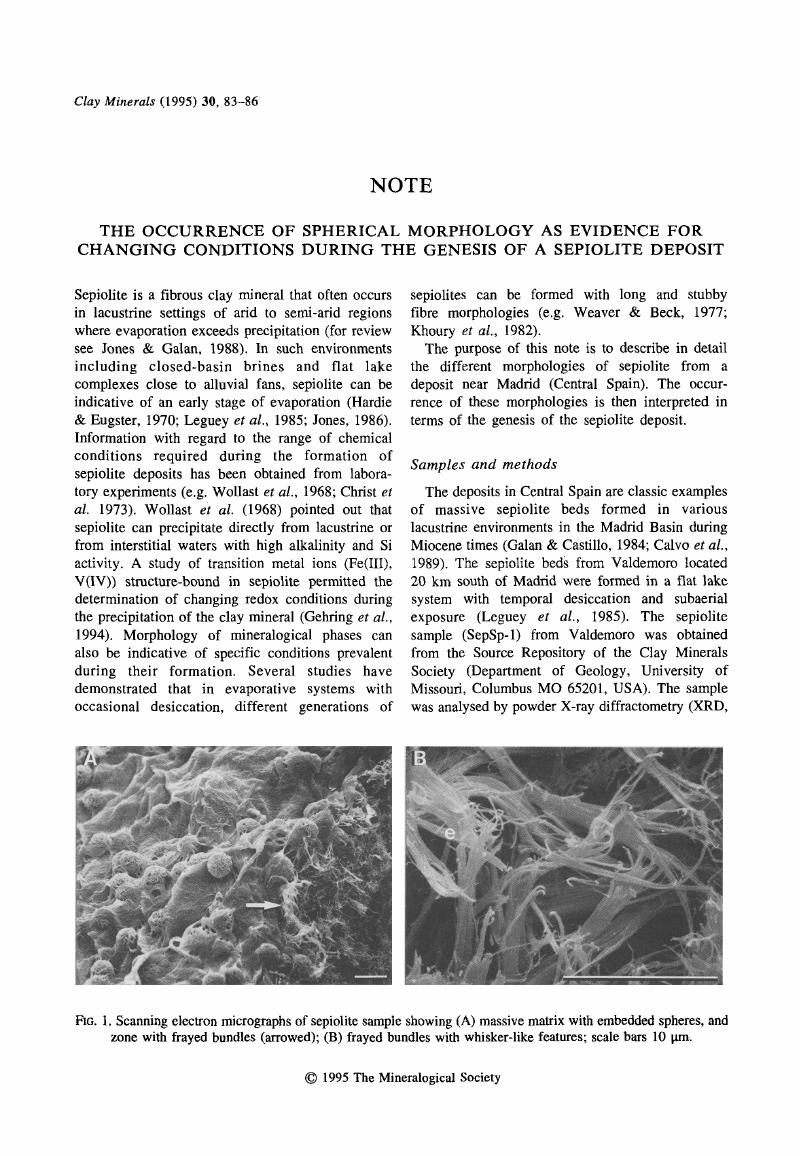Crossref Citations
This article has been cited by the following publications. This list is generated based on data provided by Crossref.
Singer, A.
Stahr, K.
and
Zarei, M.
1998.
Characteristics and origin of sepiolite (Meerschaum) from Central Somalia.
Clay Minerals,
Vol. 33,
Issue. 2,
p.
349.
Stepkowska, E. T.
Perez-Rodriguez, J. L.
Jimenez de Haro, M. C.
and
Sayagues, M. J.
2002.
Study of hydration of two cements of different strengths.
Journal of Thermal Analysis and Calorimetry,
Vol. 69,
Issue. 1,
p.
187.
Akbulut, Aydoǵan
and
Kadir, Selahattin
2003.
The Geology and Origin of Sepiolite, Palygorskite and Saponite in Neogene Lacustrine Sediments of the Serinhisar-Acipayam Basin, Denizli, SW Turkey.
Clays and Clay Minerals,
Vol. 51,
Issue. 3,
p.
279.
Bustillo, Ma.A.
and
Alonso-Zarza, A.Ma.
2007.
Overlapping of pedogenesis and meteoric diagenesis in distal alluvial and shallow lacustrine deposits in the Madrid Miocene Basin, Spain.
Sedimentary Geology,
Vol. 198,
Issue. 3-4,
p.
255.
Folk, Robert L.
and
Rasbury, E. Troy
2007.
Nanostructure of palygorskite/sepiolite in Texas caliche: Possible bacterial origin.
Carbonates and Evaporites,
Vol. 22,
Issue. 2,
p.
113.
Kadir, Selahattin
and
Eren, Muhsin
2008.
The occurrence and genesis of clay minerals associated with Quaternary caliches in the Mersin area, southern Turkey.
Clays and Clay Minerals,
Vol. 56,
Issue. 2,
p.
244.
Mees, Florias
2010.
Interpretation of Micromorphological Features of Soils and Regoliths.
p.
497.
Kadir, Selahattin
Eren, Muhsin
and
Atabey, Eşref
2010.
Dolocretes and Associated Palygorskite Occurrences in Siliciclastic Red Mudstones of the Sariyer Formation (Middle Miocene), Southeastern Side of the Çanakkale Strait, Turkey.
Clays and Clay Minerals,
Vol. 58,
Issue. 2,
p.
205.
García-Romero, E.
and
Suárez, M.
2013.
Sepiolite–palygorskite: Textural study and genetic considerations.
Applied Clay Science,
Vol. 86,
Issue. ,
p.
129.
Tsai, Yo-Lin
Chang, Po-Hsiang
Gao, Zong-You
Xu, Xiao-Yuan
Chen, Yan-Hsin
Wang, Zheng-Hong
Chen, Xin-Yu
Yang, Zheng-Ying
Wang, Tzu-Hao
Jean, Jiin-Shuh
Li, Zhaohui
and
Jiang, Wei-Teh
2016.
Amitriptyline removal using palygorskite clay.
Chemosphere,
Vol. 155,
Issue. ,
p.
292.
Kadir, Selahattin
Eren, Muhsin
İkeç, Taner
Erkoyun, Hülya
Külah, Tacit
Önalgil, Nergis
and
Huggett, Jennifer
2017.
An Approach to Genesis of Sepiolite and Palygorskite in Lacustrine Sediments of the Lower Pliocene Sakarya and Porsuk Formations in the Sivrihisar and Yunusemre-Biçer Regions (Eskişehir), Turkey.
Clays and Clay Minerals,
Vol. 65,
Issue. 5,
p.
310.
Zhang, Yuedan
Wang, Lijuan
Wang, Fei
Liang, Jinsheng
Ran, Songsong
and
Sun, Jianfeng
2017.
Phase transformation and morphology evolution of sepiolite fibers during thermal treatment.
Applied Clay Science,
Vol. 143,
Issue. ,
p.
205.
Kadir, Selahattin
Eren, Muhsin
Külah, Tacit
Erkoyun, Hülya
Huggett, Jennifer
and
Önalgil, Nergis
2018.
Genesis of palygorskite and calcretes in Pliocene Eskişehir Basin, west central Anatolia, Turkey.
CATENA,
Vol. 168,
Issue. ,
p.
62.
Mees, Florias
2018.
Interpretation of Micromorphological Features of Soils and Regoliths.
p.
177.
Fernández-Menéndez, T.
García-López, D.
Argüelles, A.
Fernández, A.
and
Viña, J.
2022.
Sepiolite organic modifiers effect on pet/sepiolite nanocomposites degradation.
Polymer Testing,
Vol. 115,
Issue. ,
p.
107725.
Wang, Lu
Jin, Zhijun
Cheng, Jiewei
Sun, Qiang
Liu, Kouqi
and
Zhang, Qian
2024.
Are palygorskite and sepiolite the potential materials for underground hydrogen storage?.
Journal of Energy Storage,
Vol. 81,
Issue. ,
p.
110397.



